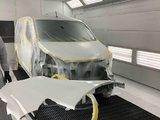Genuine Parts vs Reconditioned Parts in Auto Repair: What to Know
February 02 2024,

When it comes to auto repair, one of the critical decisions vehicle owners face is choosing between genuine and reconditioned parts. Each option has its advantages and disadvantages, and understanding these can help you make an informed decision that suits your needs, budget, and vehicle type. This article aims to demystify the differences between genuine and reconditioned auto parts, providing comprehensive information to assist in your decision-making process.
What are Genuine Parts?
Genuine parts, also known as OEM (Original Equipment Manufacturer) parts, are components made by the vehicle’s original manufacturer. They are identical to the parts your vehicle was built with and are sold through authorized dealerships.
Pros of Genuine Parts:
Quality Assurance: Genuine parts are designed specifically for your vehicle model, ensuring a perfect fit and optimal performance.
Warranty Coverage: These parts usually come with a warranty, offering peace of mind and protection against manufacturing defects.
Longevity: Since they are made to OEM standards, genuine parts tend to have a longer lifespan.
Cons of Genuine Parts:
Higher Cost: Genuine parts are typically more expensive than their reconditioned counterparts.
Availability: Some parts may not be readily available and might need to be ordered, causing delays in repairs.
What are Reconditioned Parts?
Reconditioned parts, often referred to as remanufactured or refurbished parts, are used components that have been restored to their original condition. They undergo a rigorous process of cleaning, repairing, and testing to meet specific standards.
Pros of Reconditioned Parts:
Cost-Effective: These parts are generally more affordable than genuine parts, making them a budget-friendly option.
Eco-Friendly: Opting for reconditioned parts is environmentally friendly, as it recycles existing components and reduces waste.
Availability: Reconditioned parts are usually more readily available, especially for older models where OEM parts may no longer be in production.
Cons of Reconditioned Parts:
Variable Quality: While many reconditioned parts are reliable, their quality can vary depending on the source and the reconditioning process.
Shorter Warranty Periods: Warranties, if offered, are typically shorter than those for genuine parts.
Potential for Incompatibility: There’s a slight risk of these parts not fitting perfectly or not functioning as optimally as OEM parts.
Making the Right Decision:
The choice between genuine and reconditioned parts depends on several factors:
Vehicle Age and Condition: For newer vehicles, or those under warranty, genuine parts are usually recommended to maintain the vehicle’s integrity and warranty status. For older vehicles, reconditioned parts can be a cost-effective solution.
Type of Repair: For critical components, such as engine parts or safety features, opting for genuine parts may be preferable for reliability and safety.
Budget: If cost is a significant concern, reconditioned parts offer a more affordable option without necessarily compromising on quality.
Environmental Considerations: If you’re environmentally conscious, reconditioned parts are a sustainable choice.
Understanding the differences between genuine and reconditioned auto parts is crucial in making an informed decision about your vehicle’s maintenance and repair. While genuine parts offer quality and reliability, reconditioned parts provide a more affordable and eco-friendly alternative. Ultimately, the best choice depends on your specific circumstances, including your vehicle's age, the nature of the repairs needed, your budget, and your personal preferences. It's always advisable to consult with a trusted automotive professional who can provide tailored advice based on your individual situation.





